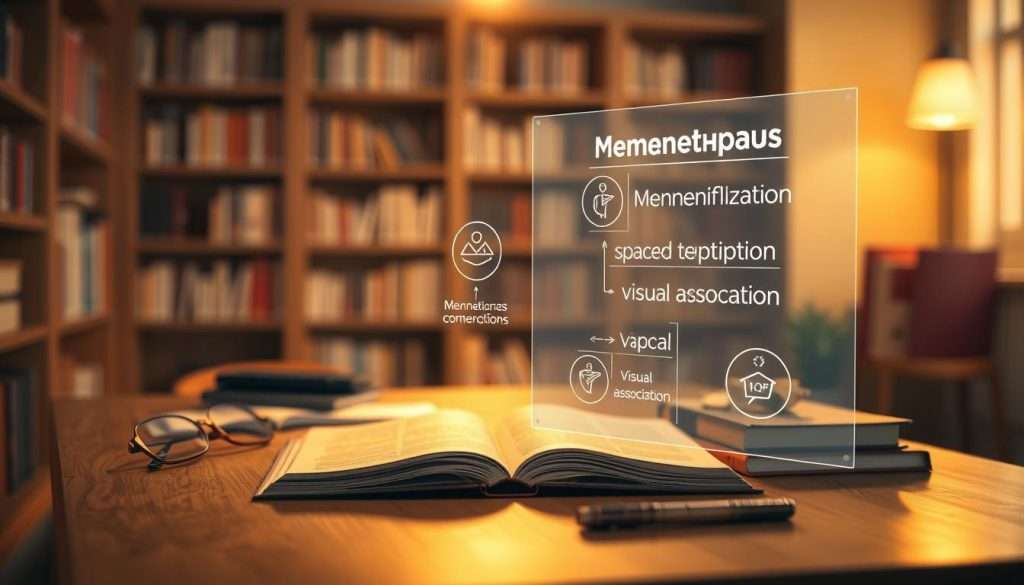Welcome to the Fastlane to Straight A’s! We’re excited to help you unlock your academic potential. You’ll learn effective study habits and strategies to make learning fun and effective.
Whether you’re a student or a lifelong learner, this guide is for you. It’s designed to help you succeed. By adopting a personalized approach to learning, you’ll be on your way to academic success.
Key Takeaways
- Discover effective study habits to boost your grades
- Learn time management techniques to optimize your study routine
- Understand how to make learning enjoyable and effective
- Develop a personalized approach to learning that works for you
- Achieve academic success with our guidance and support
The Psychology of Academic Excellence
Achieving academic excellence is more than just studying hard. It’s about understanding the psychology of successful learning. To reach your full potential, you must develop the right mindset and use effective learning strategies.
Cultivating a Growth Mindset for Learning
Having a growth mindset is key to academic success. It means believing you can grow your abilities through hard work and dedication. By facing challenges, you’re not just learning; you’re growing.
Overcoming Fixed Mindset Limitations
A fixed mindset can hold you back by making you think your abilities are fixed. To break free, you must embrace challenges as opportunities for growth. Instead of avoiding tough subjects, face them head-on. Each challenge you overcome brings you closer to academic excellence.
Embracing Challenges as Opportunities
Seeing challenges as opportunities can keep you motivated and engaged. This mindset change can greatly improve your learning results. Here’s a simple table to show the difference between fixed and growth mindsets:
| Aspect | Fixed Mindset | Growth Mindset |
|---|---|---|
| Challenges | Avoids challenges | Embraces challenges |
| Failure | Sees failure as a negative | Sees failure as a learning opportunity |
| Effort | Believes effort is for those who are not talented | Believes effort is necessary for mastery |
By adopting a growth mindset, you’ll not only improve your grades but also develop a more positive and resilient learning approach.
The “Fastlane to Straight A’s” Methodology Explained
Let’s explore the Fastlane to Straight A’s method, a game-changer for students aiming for top grades. It’s designed to help you succeed quickly and effectively in school.
Core Principles That Accelerate Academic Achievement
The heart of our method is its core principles. They focus on strategic planning, optimized execution, and continuous refinement. Together, they form a strong study system.
| Principle | Description | Benefit |
|---|---|---|
| Strategic Planning | Setting clear goals and priorities | Focus on what’s important |
| Optimized Execution | Implementing effective study habits | Maximize learning efficiency |
| Continuous Refinement | Reviewing and adjusting your approach | Stay on track and adapt to changes |
Why Traditional Study Methods Fall Short
Traditional study methods often fail because they lack a personalized approach. Our method fixes this by tailoring study techniques to fit your needs.
The Three-Phase Approach to Rapid Learning
Our three-phase approach is the core of the Fastlane to Straight A’s method.
Phase 1: Strategic Planning
In this phase, you’ll set clear goals and priorities. This creates a roadmap for your success.
Phase 2: Optimized Execution
Here, you’ll use effective study habits and time management. This maximizes your learning.
Phase 3: Continuous Refinement
This final phase is about reviewing and adjusting your approach. It helps you stay on track.
By following these phases and principles, you’ll be on your way to straight A’s. You’ll also enjoy a more effective studying experience.
Setting Strategic Academic Goals That Drive Results
Your academic success story starts with the goals you set. Setting strategic academic goals is crucial to achieving success. By having a clear direction, you can focus your efforts on what’s truly important.
Crafting SMART Goals for Each Semester
Crafting SMART (Specific, Measurable, Achievable, Relevant, Time-bound) goals for each semester helps you create a roadmap for your academic journey. For instance, instead of saying “I want to do well,” a SMART goal would be “I aim to achieve a GPA of 3.5 or higher this semester by attending all classes and completing all assignments on time.”
Breaking Down Course Objectives into Weekly Targets
Breaking down larger course objectives into smaller, manageable weekly targets makes the task less daunting. This approach allows you to stay on track and make consistent progress throughout the semester.
Creating Accountability Systems That Work
Creating systems that hold you accountable is vital for achieving your academic goals. This can be achieved through various methods.
Digital Tracking Tools
Utilizing digital tools such as Trello or Asana can help you track your progress. These platforms allow you to set reminders, assign tasks, and monitor your achievements.
Accountability Partners
Having an accountability partner, whether it’s a classmate or a friend, provides an additional layer of motivation. Regular check-ins with your partner can help you stay committed to your goals.
| Goal Setting Strategy | Description | Benefits |
|---|---|---|
| Crafting SMART Goals | Setting specific, measurable, achievable, relevant, and time-bound goals | Provides clear direction and focus |
| Breaking Down Objectives | Dividing larger objectives into smaller, weekly targets | Makes the task less overwhelming and promotes consistent progress |
| Accountability Systems | Using digital tools and accountability partners | Enhances motivation and commitment to achieving goals |
Time Management Systems for High-Achieving Students
Effective time management can be the key to getting straight A’s. By creating a schedule that fits you and focusing on the most important tasks, you can boost your productivity. This helps you reach your academic goals.
Designing Your Ideal Weekly Schedule
Creating a weekly schedule that matches your academic goals is key. It keeps you organized and focused on what matters most.
Prioritizing Tasks Using the Eisenhower Matrix
The Eisenhower Matrix is a great tool for sorting tasks by urgency and importance. It divides tasks into four areas: urgent & important, important but not urgent, urgent but not important, and not urgent or important.
| Quadrant | Task Type | Action |
|---|---|---|
| 1 | Urgent & Important | Do Immediately |
| 2 | Important but Not Urgent | Schedule |
| 3 | Urgent but Not Important | Delegate |
| 4 | Not Urgent or Important | Eliminate |
Allocating Time for Deep Work vs. Shallow Work
It’s important to know the difference between deep work and shallow work. Deep work is complex and needs full focus. Shallow work is simpler and can be done quickly.
Set aside specific times for deep work, avoiding distractions. Use shallow work time for tasks like emails or phone calls.
By using these time management tips, you’ll be ready to tackle your school work and reach your goals.
Advanced Note-Taking Methods That Enhance Understanding
Effective note-taking is key to doing well in school. We’re going to explore some advanced methods to boost your learning. These strategies will help you understand and remember information better.
The Cornell Method: Structure for Better Recall
The Cornell Method divides your paper into two parts. The smaller side is for keywords and questions. The bigger side is for your notes. This method encourages active recall and makes reviewing easier.
Mind Mapping for Conceptual Understanding
Mind mapping is a visual way to organize information. It uses circles, arrows, and colors to link ideas. It’s great for subjects with many connections. By visualizing relationships between ideas, you can understand complex topics better.
Digital Note Organization Systems
In today’s world, keeping notes organized is easy. Digital systems offer tools to manage your notes well.
Cloud-Based Note Management
Cloud-based systems let you access your notes anywhere. Services like Evernote and OneNote let you sync your notes across devices. This means you always have what you need.
Tagging and Categorizing for Easy Retrieval
Tagging and categorizing your digital notes makes finding information easy. Using keywords and categories, you can quickly locate the notes you’re looking for. This saves time and reduces stress.
Using these advanced note-taking methods will help you succeed in school. Whether you like traditional methods like the Cornell Method or digital ones, the important thing is to find what works for you and stick with it.
Memory Enhancement Techniques for Exam Domination
To ace your exams, you need more than just hard work. You need smart memory enhancement techniques. Let’s explore some powerful methods to boost your memory and dominate your exams.
Implementing Spaced Repetition for Long-Term Retention
Spaced repetition is a technique that involves reviewing material at increasingly longer intervals. This helps solidify it in your long-term memory. It’s especially effective for exam preparation.
Digital Flashcard Systems
Using digital flashcard systems like Anki can streamline your study process. These systems use algorithms to optimize the review schedule. This ensures you’re always reviewing material just before you’re likely to forget it.
Optimal Review Schedules
Creating an optimal review schedule is crucial. Here are some tips:
- Review material within 24 hours of initial learning
- Review again after 1 week, 1 month, and 3 months
- Adjust the schedule based on your retention
Creating Powerful Mnemonic Devices
Mnemonic devices are memory aids that help you associate new information with something already familiar. This makes it easier to recall. Examples include acronyms, rhymes, and mind maps.
For instance, you can use the acronym ROY G BIV to remember the colors of the rainbow (Red, Orange, Yellow, Green, Blue, Indigo, Violet).
Memory Palace Techniques for Complex Information
The Memory Palace technique, also known as the Method of Loci, involves visualizing a familiar place. You associate the information you want to remember with specific locations in that space.
Here’s how to use it:
- Choose a familiar location, like your home
- Visualize the information you want to remember at specific locations
- Practice walking through the location and recalling the information

By incorporating these memory enhancement techniques into your study routine, you’ll be well on your way to exam domination. Remember, the key is to find what works best for you and stick to it.
Strategic Reading Approaches for Different Academic Disciplines
Reading well is key to doing well in school. Using the right reading strategies can really help you understand and remember what you read. Each subject needs its own special way to read to get the most out of it.
The SQ3R Method for Comprehensive Comprehension
The SQ3R Method is a great way to read. It has five steps: Survey, Question, Read, Recite, and Review. This method makes you more active in your reading, helping you remember better.
- Survey: Look at the headings and subheadings to get the big picture.
- Question: Turn headings into questions to help guide your reading.
- Read: Read while looking for answers to your questions.
- Recite: Summarize the answers out loud.
- Review: Go over the material again to make sure you understand it.
Speed Reading Without Sacrificing Understanding
Speed reading can be good, but you must keep understanding what you read. Here are some tips:
Chunking Techniques
Chunking means grouping words together to read them faster. Try to recognize common phrases or groups of words to get better at it.
Peripheral Vision Expansion
Seeing more at a glance can help you read faster. Try focusing on the center of a page while still noticing the edges.
| Technique | Description | Benefit |
|---|---|---|
| SQ3R Method | A structured reading technique involving Survey, Question, Read, Recite, and Review. | Improved comprehension and retention |
| Chunking | Grouping words into units for faster reading. | Increased reading speed |
| Peripheral Vision Expansion | Training to see more text at once. | Enhanced reading efficiency |
Using these reading strategies can really improve your grades in different subjects.
Test Preparation Frameworks That Guarantee Top Scores
It’s time to focus on test preparation frameworks for top scores. Effective preparation is key to success. We’ll share strategies to help you achieve it.
Creating Comprehensive Study Guides
A comprehensive study guide is vital for exam prep. Start by gathering all study materials, like class notes and textbooks. Organize them using headings and bullet points for easy access.
Use digital tools or a physical binder to keep everything together. Regularly review and update your guide to stay on track.
Practice Testing Methodologies
Practice testing is crucial for preparation. It helps you focus and build confidence. Here are some methods:
Self-Generated Questions
Creating your own questions is a great way to practice. Identify key concepts and make questions to test your understanding. Use flashcards or quizzes to test yourself.
Simulating Exam Conditions
Simulating exam conditions is another effective method. Set up a timed, closed-book test environment. This simulates the real exam pressure and helps you perform better.
By using these frameworks, you can ensure top scores. Stay focused, motivated, and committed to your goals. You’ll ace your exams.
Leveraging Digital Tools for Academic Advantage
In today’s digital world, the right tools can greatly improve your academic success. Students are always searching for ways to boost their productivity and stay organized. This helps them excel in their studies.
Essential Productivity Apps for Students
Productivity apps help you manage your time better, stay focused, and keep up with assignments. Let’s explore some of the most helpful apps.
Task Management Systems
Apps like Trello and Asana let you organize tasks and projects. They help you prioritize, set deadlines, and work with classmates.
Focus-Enhancing Applications
Apps such as Freedom and StayFocusd block distractions. They keep you focused, helping you use your study time wisely.
Subject-Specific Learning Platforms
Many digital platforms focus on specific subjects, offering interactive learning. For example, Khan Academy has lessons in math, science, and humanities.
| Platform | Subject | Key Features |
|---|---|---|
| Khan Academy | Math, Science, Humanities | Video lessons, practice exercises, personalized progress tracking |
| Duolingo | Languages | Gamified learning, interactive exercises, bite-sized lessons |
| Coursera | Various disciplines | University-level courses, video lectures, peer-graded assignments |
Using these digital tools can greatly improve your academic performance. It helps you reach your goals more efficiently.

Optimizing Your Study Environment for Maximum Focus
Creating a great study space can really help you stay focused and productive. A well-designed area can make learning easier and help you remember things better.
Designing a Distraction-Free Physical Space
To make a good study area, first get rid of distractions. Find a quiet spot away from busy places and turn off your phone’s notifications. You might want to use a noise-cancelling headset or listen to calming music to help you focus.
Environmental Psychology for Enhanced Learning
How we learn is influenced by our environment. Things like lighting, sound, and ergonomics can really affect our focus and how productive we are.
Lighting and Sound Considerations
Good lighting can reduce eye strain and make you feel better. Natural light is best, but a good desk lamp can work if you can’t get natural light. Some people like complete silence, while others prefer background noise. Try different things to see what works for you.
Ergonomics for Extended Study Sessions
Ergonomic furniture is key for avoiding discomfort and injury during long study times. Make sure your chair is the right height and your computer is at a comfortable distance. This will help you stay focused for longer.
Building Strategic Relationships with Professors and Peers
Connecting with professors and peers can change your academic game. It offers support, guidance, and new opportunities. To achieve academic success, learning how to build and use these relationships is key.
Effective Communication Strategies with Instructors
Talking well with your teachers is crucial for a great academic experience. It’s not just about being in class. It’s about really connecting with your professors.
Making the Most of Office Hours
Office hours are a treasure many students miss. They offer one-on-one help, chance to clear up questions, and show you’re serious about learning. It’s a chance to build a strong relationship with your teachers, who can offer more specific advice and support.
Email Etiquette That Gets Results
When emailing teachers, it’s important to get it right. Be clear, to the point, and polite. Use a good subject line, address them correctly, and check your email for mistakes. This shows you’re dedicated to your studies and value their time.
Forming Productive Study Groups
Study groups are great for learning together. They offer a chance to share knowledge and learn from each other. To make a good study group, find classmates who are eager to learn. Set clear goals and plans for your study times to keep everyone focused.
Peer Teaching as a Learning Accelerator
Teaching others can really help you learn. By explaining things to your friends, you make sure you understand them well. You also help your friends, making everyone better off.
Using these tips, you can create strategic relationships that boost your grades and make learning more fun. Remember, academic success is not just about hard work. It’s also about the friends you make along the way.
Conclusion: Maintaining Your Academic Edge Long-Term
To keep your academic edge, you must keep working hard and stay focused. Use the tips from this guide to succeed in school for a long time.
We talked about many ways to learn faster, like growing your mind and using digital tools. Set clear goals and break down big tasks into smaller ones to stay on track.
Good time management, taking better notes, and improving your memory are key. These skills will help you handle school work well and succeed.
Keep checking your progress and change your plan if needed. Stay true to your goals and ask for help when you need it. With hard work and the right attitude, you can keep your academic edge and achieve long-term success.

